Plaintiffs in Suit Argue Cheap California Wine Has Too Much Arsenic for Their Taste

There is a high price to be paid for drinking cheap wine, according to a lawsuit (pdf) filed in Los Angeles County Superior Court, and it’s not a sharp, sulfury, metallic taste, musty odor or wicked hangover.
It’s arsenic.
Lawyers for four Californians are seeking class-action status in a suit against 28 wineries in the state for producing, manufacturing and/or distributing “wine in California that contains inorganic arsenic in amounts far in excess of what is allowed in drinking water.”
The suit claims that three separate laboratories tested 1,306 bottles of wine and found 83 with excessive arsenic levels. In some cases, arsenic levels were said to be 500% higher than what is considered “the maximum acceptable safe daily intake limit.”
“Put differently, just a glass or two of these arsenic-contaminated wines a day over time could result in dangerous arsenic toxicity to the consumer,” the lawsuit says, yet, there are no warning labels. Arsenic has been linked to heart disease, cancer, stroke, chronic lower respiratory diseases and diabetes.
Most of the affected wines cost less than $10 a bottle and much of it sold for under $5. Kevin Hicks, CEO of Beverage Grades, which performed testing in Denver, told LA Weekly, “The lower the price of wine on a per-liter basis, the higher the amount of arsenic.”
Hicks said Charles Shaw’s “Two-Buck Chuck” White Zinfandel registered three times arsenic level allowed in water by the U.S. Environmental Protection Agency (EPA). Ménage à Trois moscato was four times the limit and a Franzia white grenache quintupled the limit.
While arsenic occurs naturally in water, soil and air, lead attorney Brian Kabateck told the Associated Press that tests showed the arsenic was “inorganic” and may have been introduced during the wine-making process.
The lawsuit seeks to have wines tested for arsenic and the results printed on labels, which typically contain little information beyond the alcoholic content and sulfur level.
“Defendants’ California wine consumers have been made unwitting “guinea pigs” of arsenic exposure, being involuntarily exposed to toxic levels of inorganic arsenic over and over again by the defendants,” the lawsuit claims.
Defendants do not concur.
“There are no [EPA] limits for other foods and beverages—including wine—because they're not consumed at the same level as water and not deemed to be a risk,” Wine Institute Vice President Nancy Light told Wine Spectator. “There is no research that shows that the amount of arsenic in wine poses any health risks to consumers.”
“We believe this allegation is false and misleading and that all wines being sold in the U.S. marketplace are safe,” the institute said in a release. The institute represents more than 1,000 wineries and affiliated businesses.
University of California at Davis Professor Roger Boulton told Wine Spectator, “We do not have reliable data for winegrape juices, water sources or winemaking additives to understand where the higher-than-average levels are coming from.”
–Ken Broder
To Learn More:
Lawsuit Claims California Wines Contain Dangerous Arsenic Levels (by Ben O'Donnell, Wine Spectator)
Lawsuit: Dangerous Arsenic Levels Found in California Wine (by John Rogers, Associated Press)
Lawsuit Alleges High Arsenic Levels in Some California Wines (by Cathy Siegner, Food Safety News)
Hold the Franzia and Two Buck Chuck. Your Cheap Wine May Be Filled with Arsenic (by Samantha Bonar, LA Weekly)
Doris Charles, Alvin Jones et al v. The Wine Group et al (Los Angeles County Superior Court) (pdf)
- Top Stories
- Controversies
- Where is the Money Going?
- California and the Nation
- Appointments and Resignations
- Unusual News
- Latest News
- California Forbids U.S. Immigration Agents from Pretending to be Police
- California Lawmakers Urged to Strip “Self-Dealing” Tax Board of Its Duties
- Big Oil’s Grip on California
- Santa Cruz Police See Homeland Security Betrayal in Use of Gang Roundup as Cover for Immigration Raid
- Oil Companies Face Deadline to Stop Polluting California Groundwater





